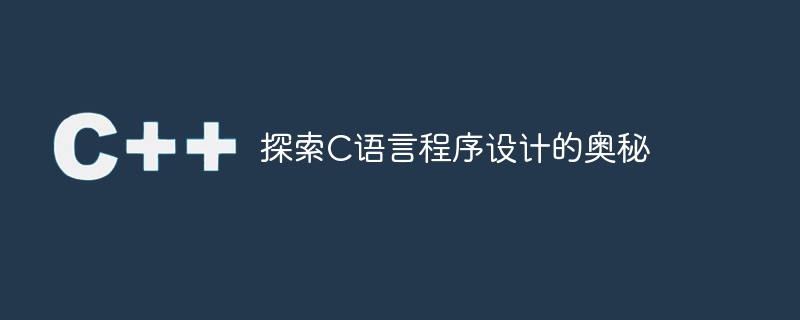Home >Backend Development >C++ >Revealing the Exploration Journey of C Language Programming
Revealing the Exploration Journey of C Language Programming
- PHPzOriginal
- 2024-02-25 16:30:121165browse

C language is a programming language widely used in the fields of computer science and programming. It is simple, efficient and flexible, and is widely used to develop various software and systems. This article will lead readers to explore the mysteries of C language programming and understand its basic features, grammatical rules and common applications.
One of the characteristics of C language is its simplicity. Compared with some other programming languages, C language has relatively few grammatical rules and its expression is intuitive and clear. Its key features include powerful data types and operators that provide flexibility in handling a variety of data and logical operations. In addition, C language also supports a process-oriented programming model, making the organization and structure of the program clearer and easier to understand.
The efficiency of C language makes it the first choice language for developing underlying systems and embedded devices. Because its syntax rules map directly to machine code, C programs can run more efficiently. This is particularly important for resource-constrained embedded devices and high-performance computer systems. In addition, C language also has a wealth of library functions and tools, which can easily perform system calls, memory management, file operations, etc. These characteristics make the C language an indispensable tool for developing system-level software such as operating systems, network protocols, and drivers.
Mastering the basic grammatical rules of C language is the key to learning programming. The syntax of C language includes basic elements such as variable declaration, operators, loops and conditional statements. Variable declarations are used to define and initialize variables, which can store different types of data such as integers, floating point numbers, and characters. Operators are used to perform arithmetic and logical operations, such as addition, subtraction, multiplication, division, remainder, etc. Loops and conditional statements allow programs to perform different functions based on specific conditions. By learning these grammatical rules, programmers can write a variety of powerful programs.
C language programming is not limited to console applications, but can also be used to develop graphical interface applications and games. By using different library functions and tools, programmers can create beautiful, interactive user interfaces. The graphics library and game development engine enable C language programming to achieve highly complex graphics effects and animation effects. These applications have enriched the application fields of C language, making it widely used in program development in different fields.
In addition, C language also has good portability. Because C language programs can be directly converted into machine code for execution, and machine code is the native instruction of the underlying computer hardware, programs written in C language can run on different operating systems and platforms. This makes C an ideal language for developing software across platforms.
Overall, C language is a powerful and widely used programming language. By learning the grammatical rules and application skills of C language, programmers can master basic programming principles and coding skills, laying a good foundation for further in-depth study of other programming languages. At the same time, mastering programming in C language is also an important step in improving computer science and programming skills. I hope that readers will have a deeper understanding and interest in C language programming through the introduction of this article, and further learn and apply this great programming language.
The above is the detailed content of Revealing the Exploration Journey of C Language Programming. For more information, please follow other related articles on the PHP Chinese website!

